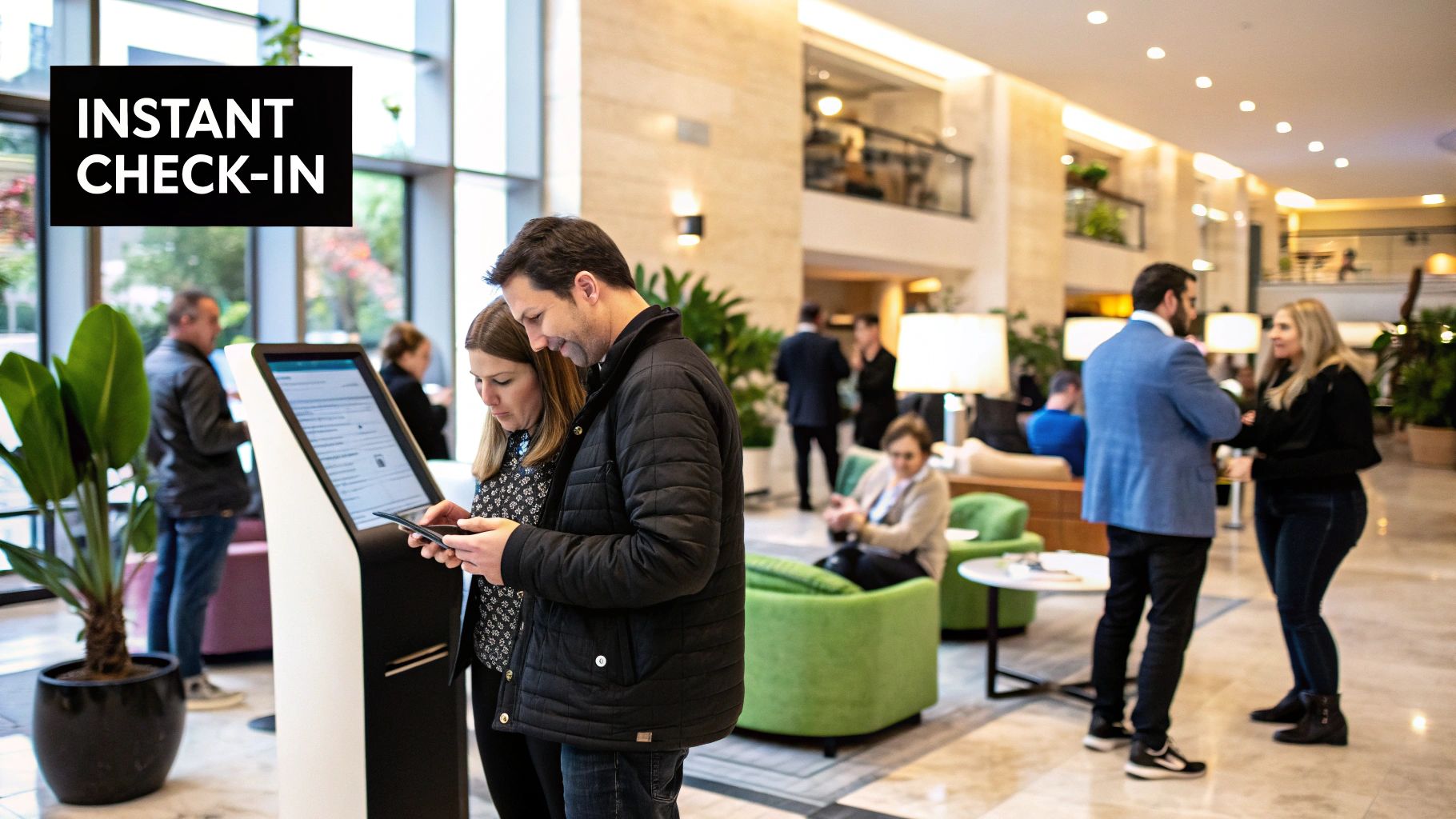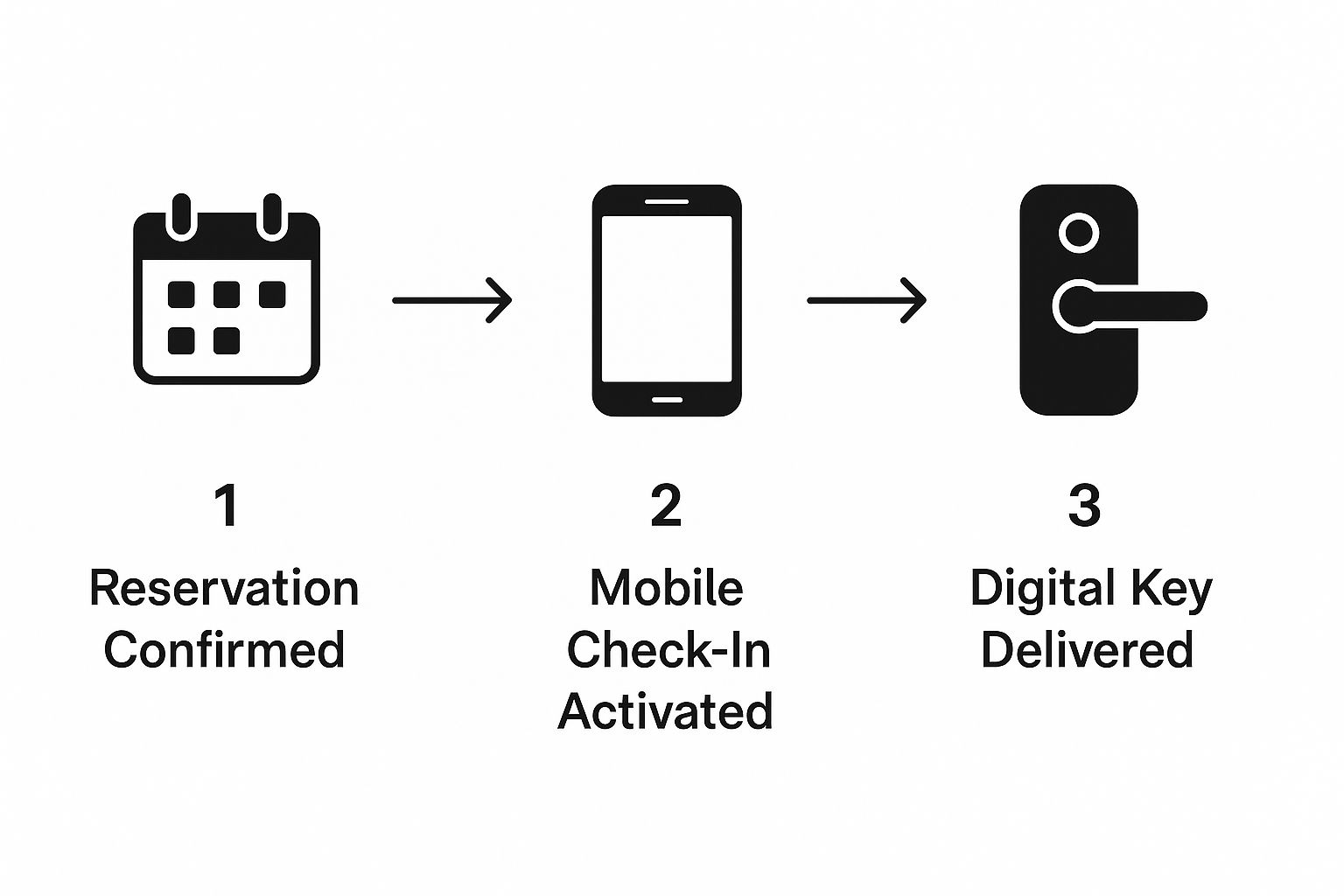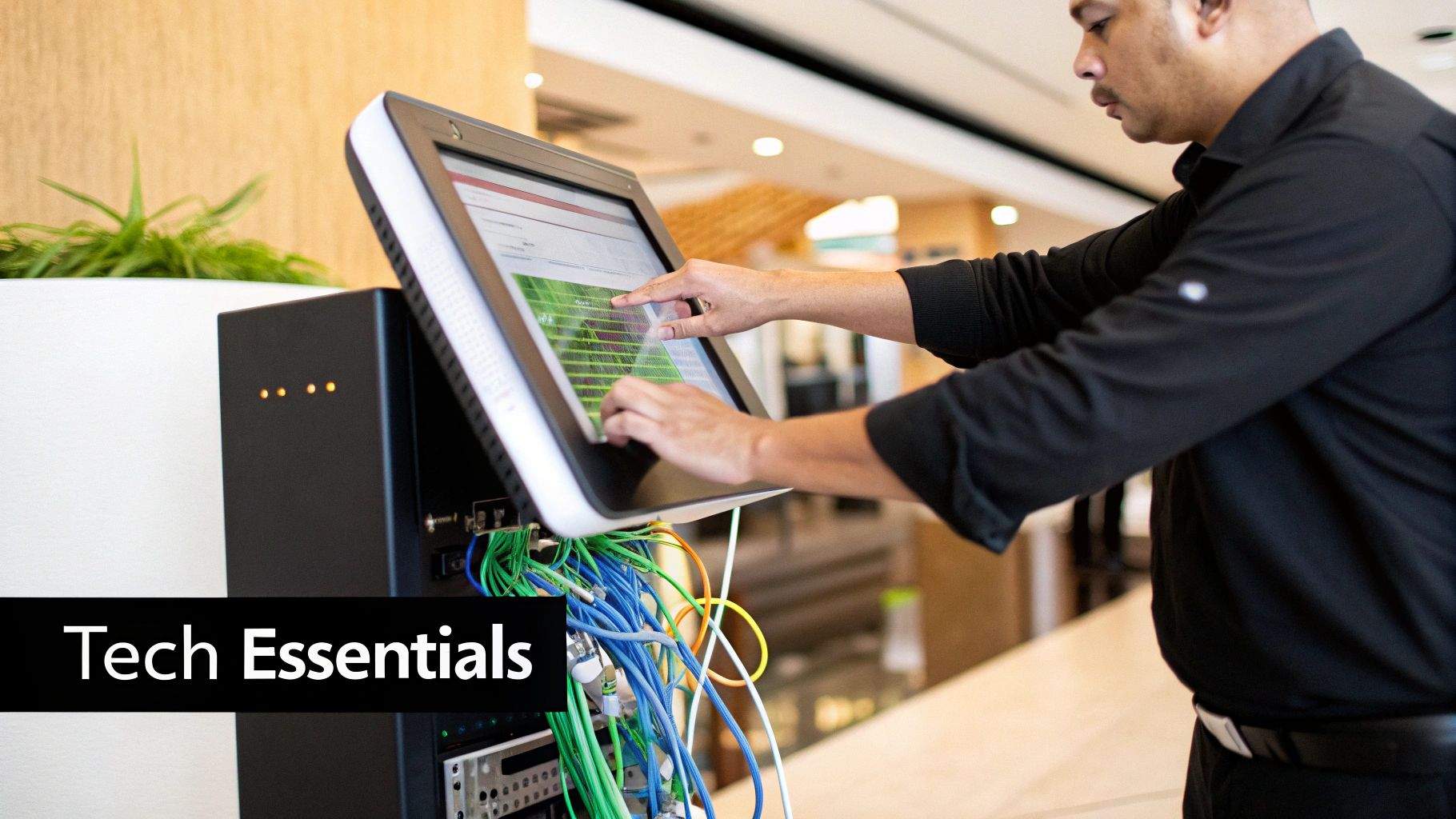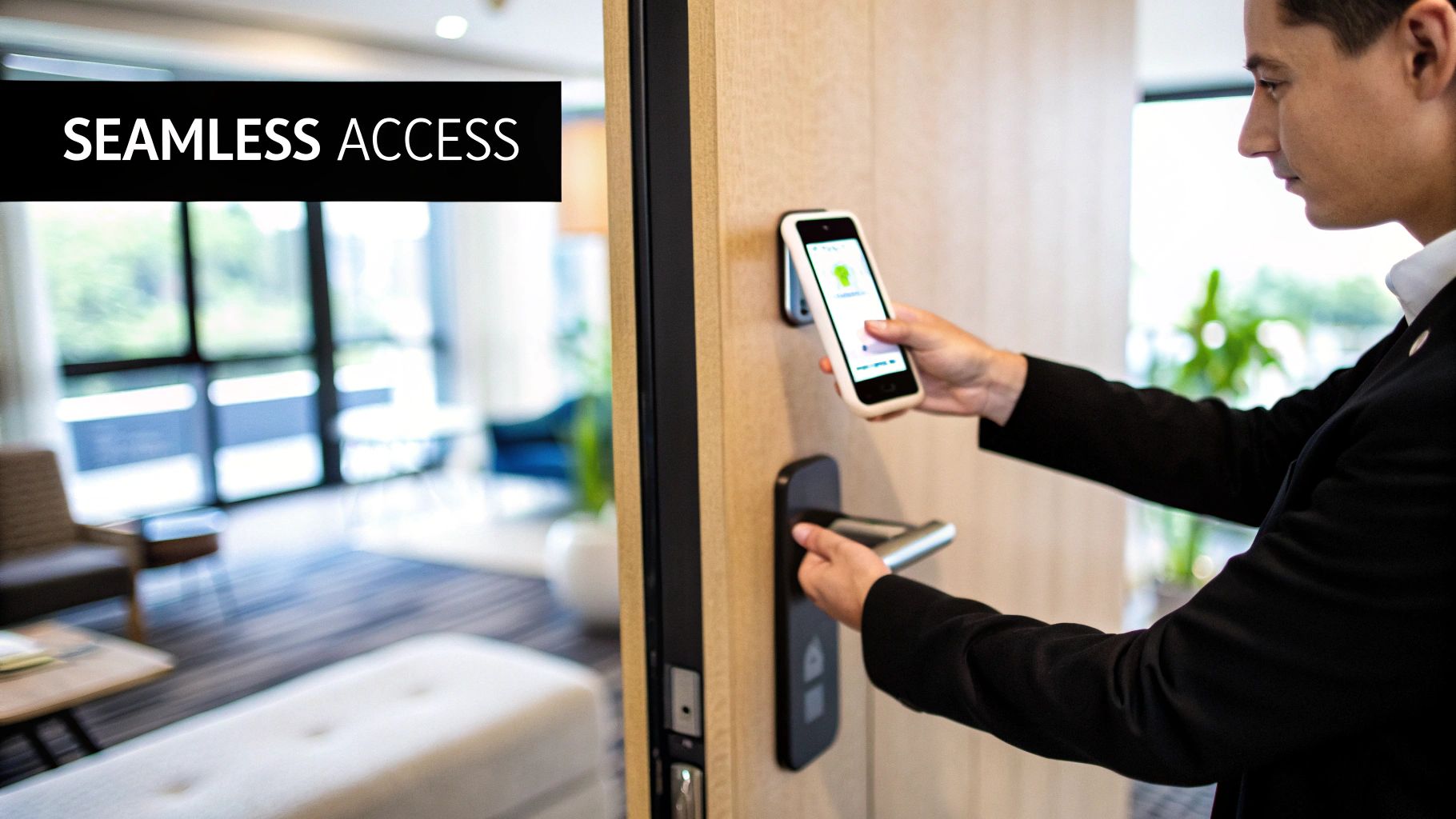Contactless Hotel Check In Guide for Hoteliers
July 4, 2025
Let's be honest, the traditional front desk check-in is starting to feel a bit dated. Nobody loves waiting in line after a long flight, fumbling with paperwork, and then waiting again for a physical keycard.
What started as a safety measure a few years ago has quickly become a basic expectation. Contactless hotel check-in is no longer just a nice perk; it's what modern, tech-savvy travelers demand. It’s a simple, digital process that lets guests handle everything—ID verification, payment, and even getting their room key—right from their own phone or a lobby kiosk, skipping the front desk entirely.
The New Standard in Modern Hospitality
This isn't just a fleeting trend. The numbers tell a powerful story. The global market for contactless hotel check-in was valued at $1.5 billion in 2023 and is on track to more than triple, hitting $4.8 billion by 2032.
This explosive growth is coming directly from guest demand. Research shows that 71% of hotel guests are more likely to book a stay at a property that offers self-service options. On top of that, integrating automated upsells during mobile check-in can boost per-guest spending by 20% or more, according to data from OysterLink.com.
Beyond Convenience The Core Benefits
Switching to a contactless system is about more than just skipping a queue. It's a smart operational move that delivers real, measurable results across your property.
- Freed-Up Front Desk Staff: When you automate the repetitive administrative work, your front desk team can stop being transactional clerks. They are freed up to become true hospitality ambassadors—offering a warm, personal welcome, sharing local tips, and handling more complex guest needs.
- A Better Guest Experience: Today, guests compare your hotel's digital experience to the seamlessness of Uber and Amazon. A smooth, fast arrival is no longer a bonus; it's a must. Putting guests in control of their own check-in immediately boosts satisfaction scores and sets a positive tone from the very first moment.
- New Ways to Generate Revenue: The check-in process is a golden opportunity for upselling. An automated system can intelligently offer room upgrades, late check-out, or breakfast packages right when a guest is most engaged. This creates new income that was often missed in a traditional, hurried check-in.
We've put together a quick summary of how these changes can impact your hotel's performance.
Contactless Check-In Impact at a Glance
| Area of Impact | Key Benefit | Supporting Statistic |
|---|---|---|
| Guest Preference | Higher Booking Likelihood | 71% of guests prefer hotels with self-service. |
| Revenue Generation | Increased Per-Guest Spending | Upsells can increase spending by 20% or more. |
| Operational Efficiency | Reduced Administrative Load | Frees staff for high-value guest interactions. |
| Market Growth | Future-Proofs Your Hotel | The market is projected to reach $4.8 billion by 2032. |
Ultimately, a well-designed contactless system creates a win-win scenario. Guests get the fast, secure, and independent experience they want, while your hotel improves efficiency, drives more revenue, and elevates its brand image.
This isn't just about modernizing. It's about future-proofing your operations and connecting with today's traveler on their terms. The real goal is to make the technology so smooth that it becomes invisible, leaving only a fantastic first impression.
For a deeper look at how to get started, check out our complete guide on using QR codes for hotels and resorts.
Building Your Contactless Technology Stack

Alright, let’s talk tech. Choosing the right technology is what makes or breaks a contactless hotel check in system. The idea isn't just to bolt on a new feature; it's about building an interconnected system that works quietly and reliably in the background.
Your tech stack should feel like a well-oiled machine. Not a Frankenstein's monster of mismatched apps.
At the very heart of this setup is your Property Management System (PMS). This is the big one. Any contactless tool you're even thinking about has to integrate deeply and flawlessly with your specific PMS. Seriously, this part is non-negotiable. If it doesn't, you’ll be stuck with manual data entry and syncing headaches that completely miss the point of automation.
From there, you'll need to piece together the other critical parts. Think of things like a secure payment gateway for handling those pre-arrival charges, a digital ID verification tool that actually complies with local laws, and a system for issuing digital keys.
You basically have two ways to go about this: grab an all-in-one suite or build your own custom stack.
All-In-One Suites Versus Custom Stacks
An all-in-one platform is all about simplicity. You get one vendor, one contract, and a system that’s already built to work together. For many independent hotels or smaller chains without a big IT department, this can be a fantastic way to get up and running fast.
On the other hand, a "best-of-breed" approach gives you way more flexibility and power. This is where you hand-pick the absolute best software for each job—the top-rated ID verification tool, the most trusted payment gateway in your market—and integrate them with your PMS. This custom stack gives you much more control over the guest experience and sets you up better for future growth.
The choice here isn't just about technology; it's a strategic one. An all-in-one system is for speed and simplicity. A custom stack is for performance and total control over your guest journey.
Your Vendor Vetting Checklist
When you start looking at different technology partners, you need to cut through the slick sales pitches and focus on what really matters for your day-to-day operations.
Here's what I always look for:
- Proven PMS Integration: Don't just take their word for it. Insist on seeing case studies or, even better, talking to other hotels that use the same PMS as you.
- Rock-Solid Security: Ask them how they handle guest data. You need to see end-to-end encryption and proof of compliance with standards like GDPR and PCI DSS. This is your guests' payment and identity info, after all.
- Scalability for Growth: Will this system grow with you? Think about whether it can handle more properties, complex room types, and a lot more users without slowing to a crawl.
- Intuitive User Experience: The interface has to be dead simple for both guests and your staff. A clunky, confusing process will just lead to frustration and nobody using it, which means you've wasted your investment.
This push toward digital systems isn't just some passing trend; it's quickly becoming the standard. A recent Oracle Hospitality 2025 Report noted that 54% of hotel executives are planning to keep or expand their mobile check-in offerings.
This technology gives guests the self-service options they want—from submitting their ID online to secure payments and keyless entry. It’s a huge win, especially with Gen Z and Millennial travelers. You can dig into the full report and other industry insights in TechMagic's analysis.
Designing a Seamless Guest Check-In Journey
A QR code is just a tool; the real magic is in the guest journey you design around it. A truly great contactless hotel check in system feels invisible because every single step has been thoughtfully planned out. The goal is to make the tech so intuitive that your guests don't even think about it.
This process really kicks off long before they ever walk through your doors.
The first touchpoint is usually the pre-arrival email, which you should send a day or two before their stay. This isn't just another confirmation—it's the official start of their check-in experience. Your email needs to clearly explain the mobile check-in option, really playing up the benefits, like skipping the front desk line and heading straight to their room.
Inside this email, you’ll embed a unique, secure link or the QR code itself. This one action is the key that unlocks the entire process.
From Scan to Digital Key
When a guest clicks that link or scans the code, they should never land on a generic, blank form. That’s a momentum killer. The system should immediately connect with your PMS and pre-fill their information—name, reservation dates, and booking details. This simple act of pre-population respects their time and gets the process off to a smooth start.
From there, the workflow should guide them through the next steps in a logical sequence. Think less like filling out paperwork and more like using a simple, secure app.
- Secure ID Upload: The interface should prompt them to snap a quick photo of their ID. Good technology will handle the verification in the background, making it feel fast and painless for the guest.
- Payment Authorization: Instead of fumbling for a credit card at the desk, the system presents their bill for a final look and asks for a secure digital payment authorization for the stay and any incidentals.
- Terms and Conditions: A simple checkbox to agree to hotel policies. This replaces those clunky paper registration cards nobody likes.
- Digital Key Issuance: Once everything is complete, the system confirms their check-in is done and issues a secure digital key right to their smartphone, which will activate at your designated check-in time.
This infographic breaks down that core flow of the guest journey.

As you can see, the path is linear and designed to be frictionless, moving the guest from their confirmed reservation to activating mobile check-in and finally receiving their digital key.
Troubleshooting Friction Points
Even the best systems can have hiccups. The trick is to anticipate them and build in easy fixes.
What happens if an ID photo is blurry? The system should immediately prompt them to retake it with clear, simple instructions. What if a payment card gets declined? It should offer an easy way to enter a different one without forcing them to start the whole process over.
The gold standard for a contactless experience is one where the guest never has to ask for help. Every potential point of confusion should be addressed with clear instructions, helpful tooltips, and a logical, step-by-step flow that builds confidence.
Think about a family arriving late at night. Instead of juggling luggage, tired kids, IDs, and credit cards at the front desk, they did it all from their phone in the taxi. They can walk right into the lobby, bypass any line, and go straight to their room. That isn't just convenient; it's a memorable, stress-free start to their vacation. It’s this level of thoughtful design that turns a simple QR code into a powerful hospitality tool.
Your Rollout and Staff Training Playbook

Even the most brilliant technology can fall flat without a smart rollout strategy and a team that’s fully on board. Launching your contactless hotel check in system isn't about just flipping a switch. Think of it as a carefully choreographed process, blending new tech with solid, people-focused training. The goal is to make the new process feel like a natural—and obviously better—alternative to the old way.
This all starts with rigorous, end-to-end testing. Before a single guest scans a code, your team needs to walk through the entire journey themselves. Create test reservations for every likely scenario: a standard booking, a group reservation, an OTA booking, you name it. This is how you uncover those little friction points—a confusing instruction, a slow-loading page—before they have a chance to ruin a real guest's first impression.
Preparing Your Team for Success
Your staff's confidence in the new system is just as crucial as the technology itself. They're your front line, the ones who will field questions and help guests who get stuck. This means your training needs to go beyond just showing them how it works; it has to be practical, hands-on, and based on role-playing.
Create short, scannable guides they can reference in a pinch. But more importantly, you need to practice common guest scenarios until the solutions are second nature.
- The "My Phone Died" Scenario: Staff must know how to pivot to a manual check-in or guide the guest to a kiosk smoothly and graciously, without making anyone feel like an inconvenience.
- The "QR Code Won't Scan" Scenario: Troubleshooting should be automatic. Can they check screen brightness? Wipe a smudged camera lens? Or quickly offer a direct link via SMS?
- The "I'm Not Tech-Savvy" Scenario: Your team needs to be empowered to offer warm, patient assistance. This can turn a moment of hesitation into a genuinely positive and helpful interaction.
When your team is this prepared, they see the tech not as their replacement, but as a tool that frees them up for more meaningful hospitality.
Phased Rollout and Strategic Signage
Don't try to launch property-wide overnight. A phased rollout is your best friend here. Start small with a select group, like your loyalty program members or guests in a specific room block. This creates a controlled environment where you can gather invaluable, real-world feedback and iron out any final kinks.
Think of your staff not as support for the technology, but as ambassadors for a better guest experience. Their primary role shifts from processing transactions to building relationships and solving problems, which is the true heart of hospitality.
Where you put your QR codes is also critical. They need to be in high-visibility areas where guests naturally pause. Obvious spots include lobby welcome signs, designated mobile check-in counters, and even on airport shuttle buses. The logic is a lot like setting up a smooth QR code event check-in, where clear visibility and simple instructions are everything.
And keep the messaging direct and benefit-driven: "Skip the Line. Scan to Check In." A clear call to action like that is often all it takes to encourage guests to give the new system a try.
Using Contactless Tech to Drive Revenue

Getting your contactless hotel check in system up and running is just the beginning. The real magic happens once guests start using it. This is where you can turn a simple convenience into a serious tool for boosting ancillary revenue.
Think about it: the check-in process is a moment of high engagement. Your guest is focused, invested, and already thinking about their stay. It's the perfect time to show them relevant offers that feel like helpful suggestions, not a hard sell.
Instead of your front desk staff trying to upsell during a busy check-in rush, the system can do the heavy lifting for you—smoothly and automatically.
Weaving in Automated Upsells
The trick is to weave automated offers right into the check-in flow. Just after a guest confirms their details, the system can present a simple, attractive offer based on what's available and who they are.
Here are a few real-world examples I've seen work wonders:
- The Room Upgrade: "For just $35 more per night, upgrade to a corner room with a city view. Tap to see the room."
- The Convenience Offer: "Arriving early? Secure a 12 PM check-in for $25 and start your vacation sooner."
- The Welcome Package: "Add our welcome package—a bottle of chilled prosecco and artisanal chocolates—delivered to your room for $45."
These prompts work because they're timely. The guest is already in a "booking" mindset, making them much more likely to say yes.
Your contactless check-in system should be more than a utility; it should be an intelligent concierge. By analyzing guest data, it can offer the right perk to the right person at the exact moment they are most likely to say yes, boosting both revenue and satisfaction.
From Data to Better Decisions
Beyond the immediate revenue, your contactless platform is a goldmine of operational data. It shows you exactly where guests might be getting stuck or dropping off during the process. When you dig into this user data, you can pinpoint bottlenecks and smooth them out for everyone.
This feedback loop is incredibly valuable. Consumer expectations for hygiene and digital convenience are only growing, pushing contactless tech forward. In fact, market projections show significant growth through 2033 as hotels integrate mobile and IoT tech for a more connected guest journey. It's backed by surveys showing 26% of consumers want digital room keys and 35% prefer contactless payment, which you can read more about in the full contactless check-in report from Archive Market Research.
This data-driven approach isn't unique to hospitality. It’s similar to how professionals optimize their networking by tracking how people interact with their digital business cards. The goal is always the same: use the data to make the experience better and get better results.
Of course. Here is the rewritten section, following all the provided guidelines and matching the human-like, expert tone of the examples.
Common Questions About Going Contactless
Switching to a fully digital arrival process brings up some fair questions. I talk with a lot of hoteliers who are genuinely excited by the idea, but they want to make sure all their bases are covered before they dive in. It's a smart approach.
Let's walk through some of the most common things I get asked about setting up a contactless hotel check in system. This isn't just about adding tech for the sake of it—it's about building a smarter, more efficient front desk that gives modern guests exactly what they want.
What if a Guest’s Phone Dies?
This is always the first question, and for good reason. It’s a real-world problem. The key is to see contactless as a superior option, not a forced replacement for essential service. You absolutely need a backup plan.
Here’s how to handle it:
* A Self-Service Kiosk: Having one or two kiosks in the lobby is a fantastic fallback. They can run the exact same digital workflow, giving guests a way to check in without a working phone.
* A Traditional Welcome Point: Always keep at least one front desk station staffed and ready. Train your team to handle these situations gracefully, so the check-in feels just as seamless and welcoming.
Will This Replace My Front Desk Staff?
Not at all. In fact, it does the opposite—it elevates their role. When you automate the repetitive, administrative parts of the job like checking IDs and swiping credit cards, you free up your team to become true hospitality experts.
Think of it this way: your staff’s focus shifts from being transactional to relational. They can now dedicate their time to providing a warm welcome, offering personalized local recommendations, and resolving the complex guest issues that truly require a human touch. This shift almost always leads to a dramatic improvement in the overall guest experience.
How Secure Is Guest Data?
Security is completely non-negotiable. Any provider you consider must have rock-solid security protocols. You'll want to see end-to-end encryption for all data, especially for sensitive ID scans and payment details. The QR codes themselves should also be unique and time-sensitive to prevent anyone from misusing them.
Reputable platforms are built to comply with standards like GDPR. They process and store all data on secure, protected servers—never on the guest's device itself.
Can This Integrate With My Existing PMS?
Yes, and this is a must-have. A modern contactless solution has to integrate cleanly with major Property Management Systems (like Oracle Opera, Mews, or Cloudbeds) using APIs.
Before you sign with any vendor, make them confirm that they offer a seamless, real-time integration with your specific PMS. This is crucial for keeping room statuses, guest profiles, and billing perfectly in sync.
Ready to create a seamless, revenue-driving arrival experience for your guests? RecodeQR provides the powerful, flexible tools you need to build a custom contactless check-in flow with dynamic QR codes that you can track and manage. Start your free trial today.
Ready to create your QR code?
RecodeQR is the easiest way to create QR codes you can track and edit anytime.
Free 3-day trial. No credit card required.